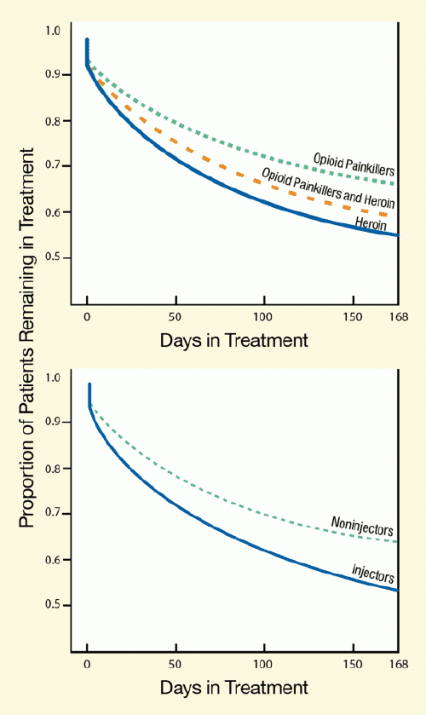Study Points to Individualized Therapy for Opioid Addiction

Addiction Research Articles
Heroin Research
Addiction Treatment Articles
Methadone Maintenance
Opioid Addiction Treatment
Suboxone Treatment
Overview
Originally Published: 02/18/2015
Post Date: 02/19/2015
Source Publication: Click here
by NIDA
Summary/Abstract
Study Points to Individualized Therapy for Opioid Addiction - heroin use and injection are markers for severe addiction, says Dr. Potter. “These patients seem to have progressed in their disease, and, as a result, they face greater challenges in treatment."
Content
Study Points to Individualized Therapy for Opioid Addiction
A recent NIDA-supported clinical trial affirmed one common supposition about medically assisted treatment for opioid addiction and challenged another. As anticipated, trial participants who were addicted to opioid painkillers and did not inject drugs stayed in treatment longer and achieved better outcomes than those who were addicted to heroin or injected drugs. However, the expectation that users of painkillers would benefit more from buprenorphine/naloxone (Bp/Nx) than from methadone therapy was not borne out.
The findings should help clinicians make optimal treatment choices for individual patients, says Dr. Jennifer S. Potter of the University of Texas Health Science Center at San Antonio. “People who inject drugs or use heroin may need more structured attention and a higher level of monitoring during treatment, because they have an increased risk for dropping out. When treating users of opioid painkillers, physicians should feel confident recommending either buprenorphine or methadone, depending on the medications’ availability and patients’ preference,” says Dr. Potter.
Prescription Opioids Versus Heroin
Dr. Potter and her team analyzed data from the Starting Treatment with Agonist Replacement Therapies (START) trial, which demonstrated that Bp/Nx and methadone are unlikely to cause liver damage. The Texas researchers used the 1,289 START participants’ self-reports of their drug use at baseline and during up to 24 weeks of treatment with one or the other medication.
The participants who used only painkillers had a higher rate of treatment completion than those who used only heroin (70 percent versus 56 percent) (see Figure). Among participants who remained in treatment for its full duration, people who used painkillers were more likely to be abstinent for at least 30 days at the end (78 percent versus 54 percent). Participants who used both painkillers and heroin at baseline had intermediate rates of treatment completion and abstinence compared with exclusive users of one or the other type of opioid.
Similarly, START participants who injected opioids were more likely than noninjectors to drop out of treatment (44 percent versus 34 percent). Injectors were roughly twice as likely as noninjectors to have recently used an opioid at the end of the treatment.
These results suggest that heroin use and injection are markers for severe addiction, says Dr. Potter. “These patients seem to have progressed in their disease, and, as a result, they face greater challenges in treatment.” Consistent with this interpretation, the START participants who used heroin were more likely than those who used painkillers to inject the drug and to be dependent on an additional drug, most often cocaine. They also, on average, were older than those who used painkillers, suggesting longer drug careers.
 Figure. Type of Opioid Used and Route of Administration Affect Treatment Retention People who used opioid painkillers completed the 24-week treatment at a higher rate than users of heroin or of both types of opioid (upper panel). Noninjectors completed treatment at a higher rate than injectors (lower panel).
Figure. Type of Opioid Used and Route of Administration Affect Treatment Retention People who used opioid painkillers completed the 24-week treatment at a higher rate than users of heroin or of both types of opioid (upper panel). Noninjectors completed treatment at a higher rate than injectors (lower panel).Text Description of Graphic
Buprenorphine Versus Methadone
Altogether, 731 patients completed the full 24-week course of treatment. Those assigned to take Bp/Nx were 60 percent more likely to drop out. Dr. Potter says this difference did not appear to be related to which type of opioid participants used or whether they injected.
Although the researchers cannot definitively explain why attrition was greater with Bp/Nx, they suggest that the finding may reflect the setting in which the treatments were administered. The study was run in nine methadone programs, some of which had no prior experience with Bp/Nx. Some participants had undergone treatment with methadone before enrolling in the trial and had been randomly assigned to Bp/Nx. Some of these patients reported that they had felt better during the earlier treatment with methadone.
Roughly half of the participants who completed treatment with each medication finished with 30 or more days of abstinence, and this finding held for patients using prescription opioids as well as those using heroin. “Some in our group expected that participants who were addicted to painkillers would do better with Bp/Nx than with methadone, but this was not the case,” says Dr. Potter.
“Dr. Potter’s study shows that clinicians can use information based on clinical baseline characteristics to tailor treatment plans to a patient’s specific needs,” says Dr. Will Aklin, NIDA Program Officer in the Behavioral and Integrative Treatment Branch. “In particular, the study suggests that the type of opiate primarily used and injection status are factors to be considered when determining what sort of treatment is most likely to retain a patient in treatment and prevent relapse.”
This study was supported by NIH grants DA020024, DA13045, DA013714, DA13036, and DA02297.
Source:
Potter, J.S.; Marino, E.N.; Hillhouse, M.P., et al. Buprenorphine/naloxone and methadone maintenance treatment outcomes for opioid analgesic, heroin, and combined users: findings from Starting Treatment with Agonist Replacement Therapies (START). Journal of Studies on Alcohol and Drugs 74(4):605-613, 2013. Full text





